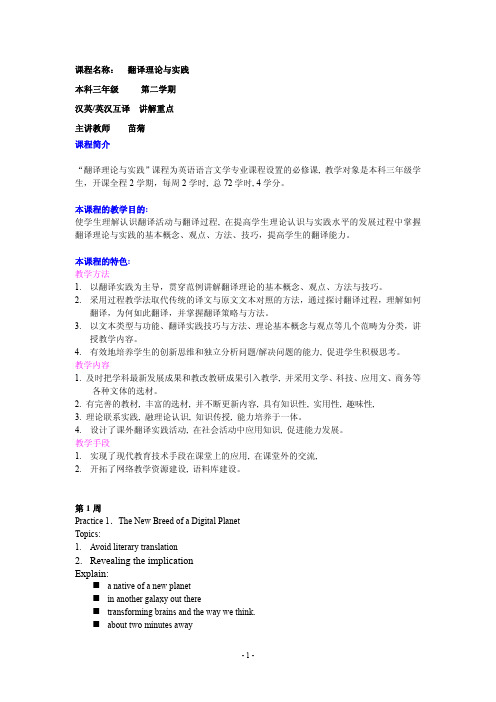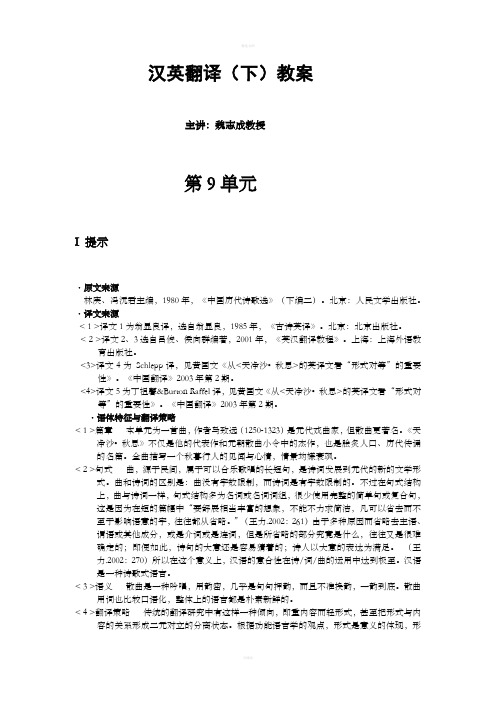广西师范学院《 英汉互译(二)》课程教案
- 格式:pdf
- 大小:197.42 KB
- 文档页数:5

英汉翻译实用教程教案第一章:翻译概述1.1 翻译的定义与历史介绍翻译的定义和作用简述翻译的历史发展1.2 翻译的类型与标准介绍不同类型的翻译(如直译、意译、同声翻译等)讨论翻译的标准(如准确性、流畅性、忠实性等)1.3 翻译的过程与方法介绍翻译的基本过程(如理解原文、表达译文等)探讨有效的翻译方法与技巧第二章:词汇翻译2.1 词汇的选择与转换讲解词汇翻译的基本原则探讨如何在翻译过程中选择合适的词汇2.2 专业术语与行业用语的翻译介绍专业术语和行业用语的特点讲解如何准确翻译专业术语和行业用语2.3 词义辨析与词性转换讲解词义辨析的重要性探讨如何在翻译过程中进行词性转换第三章:句子翻译3.1 句型结构与句子成分讲解英语和汉语句型结构的差异探讨如何在翻译过程中保持句子成分的平衡3.2 语法调整与句子重构讲解语法调整的重要性探讨如何在翻译过程中进行句子重构3.3 意译与直译的运用讲解意译和直译的区别与适用场景探讨如何在翻译过程中灵活运用意译和直译第四章:段落与文章翻译4.1 段落结构与主题句的翻译讲解段落结构的重要性探讨如何翻译段落主题句4.2 逻辑与连贯性的保持讲解翻译过程中逻辑和连贯性的重要性探讨如何保持原文的逻辑和连贯性4.3 文章风格与翻译策略讲解不同文章风格的特征探讨如何根据文章风格选择合适的翻译策略第五章:文化差异与翻译5.1 文化背景与翻译讲解文化背景对翻译的影响探讨如何在翻译过程中考虑文化背景5.2 文化词汇与翻译讲解文化词汇的特点和翻译难点探讨如何准确翻译文化词汇5.3 跨文化交流与翻译实践讲解跨文化交流的重要性探讨如何在翻译实践中应对跨文化交流的挑战第六章:翻译技巧与策略6.1 翻译中的直译与意译深入探讨直译与意译的定义和应用场景分析直译与意译在实际翻译案例中的运用6.2 翻译中的归化与异化讲解归化与异化的概念和作用探讨如何在翻译过程中运用归化和异化策略6.3 翻译中的补偿与调整分析翻译中补偿与调整的必要性和方法通过实例展示补偿与调整在翻译中的应用第七章:文学翻译7.1 文学翻译的基本原则探讨文学翻译的特殊性和原则分析文学翻译中应注重的方面7.2 诗歌、小说、戏剧等文体的翻译深入讲解不同文学文体的翻译特点和技巧通过实例分析不同文学文体的翻译方法7.3 文学翻译案例分析分析具体文学作品的翻译案例讨论文学翻译中的难点和解决策略第八章:商务翻译8.1 商务翻译的基本要求讲解商务翻译的特点和基本要求分析商务翻译中应注重的方面8.2 商务合同、广告、报告等文体的翻译深入讲解不同商务文体的翻译特点和技巧通过实例分析不同商务文体的翻译方法8.3 商务翻译案例分析分析具体商务材料的翻译案例讨论商务翻译中的难点和解决策略第九章:口译技巧与实践9.1 口译的基本类型与技巧讲解同声传译、交替传译等口译类型的特点探讨口译过程中的技巧和策略9.2 口译中的听力理解与信息处理分析听力理解在口译中的重要性讲解如何提高口译中的信息处理能力9.3 口译实践案例分析提供口译实践案例,进行分析和讨论指导如何应对口译中的挑战和困难第十章:翻译软件与工具的使用10.1 翻译软件的种类与功能介绍市面上的主要翻译软件及其功能分析翻译软件的优缺点和使用场景10.2 翻译辅助工具的使用讲解翻译辅助工具(如在线词典、术语管理工具等)的运用探讨如何提高翻译效率和质量10.3 翻译软件与人工翻译的结合讨论翻译软件与人工翻译的结合方式分析如何利用翻译软件辅助人工翻译工作重点和难点解析6.1 直译与意译的界定和应用场景是教学中的重点和难点。

大学英汉翻译教案一、教案背景本次教案适用于大学二年级英语专业学生,教学内容是英汉翻译。
该教材以英汉翻译的基本概念和方法为主要内容,旨在帮助学生掌握英汉翻译的技巧和方法,提高其英语翻译能力。
二、教学目标1. 理解英汉翻译的基本规则和原则;2. 掌握英汉翻译的常用技巧和方法;3. 提高英语语言文字表达能力和翻译能力;4. 增强学生对外语学习的兴趣和自信。
三、教学方法1. 讲授法:通过教师的讲解,让学生了解基本规则和原则,学习常用的翻译技巧和方法;2. 案例法:通过对实际案例的分析和讨论,让学生加深对英汉翻译的理解和掌握;3. 演示法:通过教师的演示和引导,让学生学会如何翻译字面意义以外的语言表达;4. 练习法:通过大量的阅读和翻译练习,提高学生的翻译能力。
四、教学内容和步骤第一部分:基本概念与规则(讲授法)1. 英汉翻译的定义和意义;2. 翻译的原则和规则;3. 翻译的基本技巧和方法;4. 翻译过程中的常见问题及解决方法。
第二部分:案例分析(案例法、演示法)1. 分析英汉翻译案例,总结翻译方法和技巧;2. 通过实例演示,讲解翻译难点,引导学生思考和探讨;3. 翻译口头语和常用短语;第三部分:翻译练习(练习法、演示法)1. 给学生派发相应的翻译材料,让学生独立完成翻译任务;2. 教师对学生的翻译进行点评和评价,指出错误并给予纠正。
五、教学效果评估方法1. 完成翻译任务并进行课堂展示;2. 准确翻译案例;3. 课堂参与度和发言质量;4. 期末成绩。
六、教学师资力量教材为该领域的教授编写,教学主要由资深教师、翻译专家负责,辅以本领域资深从业人员组成的教学团队,确保教学的专业性和实效性。
七、教材及参考书目[1] 王华. 走向世界——英译汉样例对照[M]. 北京:中国对外翻译出版公司,1987.[2] 张翼鹏. 英汉翻译实践教程 [M]. 天津:天津大学出版社,2012.[3] 邵勇华,张一建. 英汉翻译教程 [M]. 上海:上海外语教育出版社,2005.。


教学大纲课程名称英汉互译课程类型专业课总学时数64开课专业英语航空任课教师王艳梅2017年 3月《英汉互译》教学大纲一、课程基本信息课程名称:英汉互译开课学期:2学时/学分:128 /6课程类型:专业课开课专业:英语航空专业本科生二、课程简介《英汉互译》课程是全国高等教育自学考试英语专业本科段的一门必考课程。
英汉互译(包括英译汉和汉译英)是一门实践性很强的课程。
本课程简要介绍英汉互译的基本概念、英汉语言对比与翻译以及中西方翻译理论知识外,主要是通过原文与译文的对比赏析,引导考生分析研究英汉两种语言各自的特点,找出二者之间的转换规律,用以指导翻译实践。
三、相关课程的衔接预修课程:《英语语法》《综合英语》《阅读》《英语国家概况》并修课程:《高级英语》、《英美文学选读》四、教学的目的、要求与方法(一)教学目的通过本课程的学习,考生将能够熟悉英汉两种语言各自的特点,掌握英汉互译的基本概念、技巧和理论知识;能将中等难度的英语文章译成汉语,内容传达准确,句子通顺,语言流畅;能将比较简易的汉语篇章译成英语,做到用词得当,句子连贯,符合英语语法规范。
(二)教学要求培养考生理论与实践相结合,不仅学习翻译理论与技巧,还要在理论指导下进行大量的翻译实践。
本课程目的在于培养学生如何借助语言知识,主题知识,百科知识和翻译技能来对源语信息进行分析理解,并用译入语将所理解的信息表达出来,将学生培养为全才、通才、一专多能的人才,适应未来的职业发展,适应社会,有能力不断提升自身素质。
(三)教学方法1. 仔细通读原文课文。
2. 对照原文阅读译文。
3. 原文和译文对比分析。
4. 翻译实践练习。
5. 不断帮助学生提高自己的译入语语言水平。
6. 注意防止学生在翻译过程中过于机械和过于自由两种倾向。
五、各章节内容及学时分配第一部分绪论(一)学时:50(二)教学目的与要求了解翻译的一些基本概念,英汉两种语言对比分析,中国翻译理论简介,西方翻译理论简介。

汉英翻译(下)教案主讲:魏志成教授第9单元I 提示·原文来源林庚、冯沅君主编,1980年,《中国历代诗歌选》(下编二)。
北京:人民文学出版社。
·译文来源< 1 >译文1为翁显良译,选自翁显良,1985年,《古诗英译》。
北京:北京出版社。
< 2 >译文2、3选自吕俊、侯向群编著,2001年,《英汉翻译教程》。
上海:上海外语教育出版社。
<3>译文4为Schlepp译,见黄国文《从<天净沙• 秋思>的英译文看“形式对等”的重要性》。
《中国翻译》2003年第2期。
<4>译文5为丁祖馨&Burton Raffel译,见黄国文《从<天净沙• 秋思>的英译文看“形式对等”的重要性》。
《中国翻译》2003年第2期。
·语体特征与翻译策略< 1 >篇章本单元为一首曲,作者马致远(1250-1323)是元代戏曲家,但散曲更著名。
《天净沙•秋思》不仅是他的代表作和元朝散曲小令中的杰作,也是脍炙人口、历代传诵的名篇。
全曲描写一个秋暮行人的见闻与心情,情景均嫌衰飒。
< 2 >句式曲,源于民间,属于可以合乐歌唱的长短句,是诗词发展到元代的新的文学形式。
曲和诗词的区别是:曲没有字数限制,而诗词是有字数限制的。
不过在句式结构上,曲与诗词一样,句式结构多为名词或名词词组,很少使用完整的简单句或复合句,这是因为在短的篇幅中“要舒展相当丰富的想象,不能不力求简洁,凡可以省去而不至于影响语意的字,往往都从省略。
”(王力.2002:261)由于多种原因而省略去主语、谓语或其他成分,或是介词或是连词,但是所省略的部分究竟是什么,往往又是很难确定的;即便如此,诗句的大意还是容易猜着的;诗人以大意的表达为满足。
(王力.2002:270)所以在这个意义上,汉语的意合性在诗/词/曲的运用中达到极至。
汉语是一种诗歌式语言。

#### 一、课程基本信息课程名称:英汉互译基础课时:1课时适用年级:初中英语教学目标:1. 理解英汉互译的基本原则和技巧。
2. 能够进行简单的英汉互译练习,提高翻译能力。
3. 培养学生对文化差异的敏感性,提高跨文化交流能力。
#### 二、教学重点与难点教学重点:1. 英汉互译的基本原则。
2. 常用翻译技巧的应用。
教学难点:1. 文化差异对翻译的影响。
2. 翻译过程中的灵活变通。
#### 三、教学过程##### 第一部分:导入新课(5分钟)1. 教学活动:展示中英文谚语对比,引导学生思考文化差异对翻译的影响。
2. 学生活动:观察并分析谚语中的文化差异,小组讨论。
3. 教师总结:介绍英汉互译的基本原则,强调文化差异的重要性。
##### 第二部分:讲解与示范(20分钟)1. 教学活动:- 讲解英汉互译的基本原则,如忠实于原文、通顺易懂、符合语法等。
- 示范几种常用翻译技巧,如直译、意译、增译、省译等。
- 通过具体例子分析翻译过程中的灵活变通。
2. 学生活动:跟随教师学习翻译技巧,进行简单翻译练习。
3. 教师总结:强调翻译技巧的适用范围和注意事项。
##### 第三部分:实践与练习(25分钟)1. 教学活动:- 分发英汉互译练习题,包括谚语、短文等。
- 学生独立完成练习,教师巡视指导。
- 学生展示翻译结果,教师点评并给予反馈。
2. 学生活动:认真完成练习,积极展示自己的翻译成果。
3. 教师总结:总结学生在翻译过程中遇到的问题,强调注意事项。
##### 第四部分:总结与反思(5分钟)1. 教学活动:引导学生总结本节课所学内容,分享学习心得。
2. 学生活动:回顾本节课的要点,表达自己的学习体会。
3. 教师总结:鼓励学生在日常生活中多进行英汉互译练习,提高翻译能力。
#### 四、教学评价1. 过程评价:观察学生在课堂上的参与度、练习情况等。
2. 结果评价:检查学生的翻译练习成果,了解学生的学习效果。
#### 五、教学资源1. 教学课件2. 英汉互译练习题3. 教学视频或音频资料#### 六、教学反思本节课通过讲解、示范、练习等环节,帮助学生掌握英汉互译的基本原则和技巧,提高翻译能力。
广西师范学院《英汉互译(一)》课程教案编号: 15—10开课单位:外语系授课教研室:翻译写作课程名称:《英汉互译(一)》授课教师: 唐旭光教材:《新编英汉互译教程》,授课对象:06级英语专业2、3、5班《英汉互译(一)》第十讲分译法在翻译中的运用(Applicationof“Expansion andDivision"toTranslation)英汉两种语言之间存在很大差异.在进行英汉翻译时,译者必须灵活使用不同的翻译技巧与方法。
在众多的翻译技巧和方法中,分译法是改变原文句子结构的重要变通办法.所谓分译法,就是把原语句中的某个词或短语译为目的语的单句或分句,或将原语的一个长而复杂的句子译成目的语的两个或两个以上的句子,以确保译文既清晰易懂,又忠于原文。
这里探讨这种重要的句子翻译变通手法的可行性和适应性。
一、分译法在英译汉中的运用英语句中某些单词或词组有时采用分译法处理,即译为汉语的单句或复句的分句;英语句子,特别是复杂句,有时也采用分译法译成两个或两个以上的汉语句子。
分译法可使译文意思清楚,干净利落。
这种方法常见于英译汉中(王寅,1992:5).1.1译英语单词为汉语分句(1) The Chinese seemedjustifiablyproud of their economic achievements.中国人似乎为他们在经济上所取得的成就而感到自豪,这是合乎情理的.(转引自张培基,1980:109)(2) Hehadlong been held in cordial contempt by his peers; now that contempt was no longer cordial.长期以来,他的同僚虽然看不起他,却还是诚恳友好地待他;现在,他的同僚对他不屑一顾,再也不象以前那样诚挚友好了。
(同上,p。
110)(3) But,occasionally,through hastecareless—-ness,mistakeswere made, so thatat theend of the business day one teller would be short oncash,theotherlong。
《英汉翻译》课程教案•课程编号: •周课时: •总课时: •学分: •考试方式: •教材: •参考书: BZB032232342分考查新编英汉翻译教程孙致礼编英汉翻译教程张培基编实用翻译教程冯庆华编ContentsChapter 1 What Is Translation (1)Chapter 2 The Process of Translation (15)Chapter 3 The linguistic Approach toTranslation (25)Chapter 4 Conversion (35)Chapter 5 The importance of diction (43)Chapter 6 Translation concerning negation (48)Chapter 7 Ampliflcation (53)Chapter 8 Repetition (58)Chapter 9 Changes of sentence parts (62)Chapter 10 Translation of attributive clause (66)Chapter 11 Translation of Long Sentences (69)Chapter 12外位语结构在英译汉中的应用 (73)Chapter 13 Translation of Passive Voice (77)Chapter 14 Translation of figures of speech (83)Chapter 15 Translation of idioms (87)Chapter 1 What Is TranslationAims: To understand the basic principles of translation and translation studiesKey points: the nature of translation, definition of translationDifficulties: the nature of translation, history of translationTeaching procedures1.The nature of translation•Translation is of great importance in learning a foreign language. Many of those who learn English will be English Chinese translators in the future. There are many translation theories and techniques for you too learn .•Without knowing the theories and the techniques one will most likely take a roundabout course in translation work. That's why it is necessary for you to have a good command of both the source language and the target language, and of the theories and the techniques in translation.•What is translation?Translation is a representation or recreation in one language of what is written or said in another language.or : Translation is an activity of reproducing in one language the ideas which have been expressed in another language.(翻译是把一种语言所表达的思想用另一种语言重新表达出來的活动)•Eugene Nida, famous American translation theorist, defined translation as: Translation consists in reproducing in the receptor language the closest natural equivalent of the source-language messages, first in terms of meaning and secondly in terms of style.•翻译就是接受语言复制出与原语信息最接近的自然等值体…首先是就意义而言,其次是就其风格而言.Eugene Nida^s photo •In addition to the definitions mentioned above, various definitionshave been given to translation. Now Fd like to cite some of them:•Translation is a science ••Translation is an art.•Translation is a craft.•Translation is a skill.•Translation is an operation .•Translation is a language activity .•Translation is a communication.•Among these definitions the first two are most important for they represent two schools ■一the school of science and the school of art. The former maintains that translating should reproduce the message of the original by means of the transformation of linguistic equivalence. It puts stress on the study of description of the process of translation, and the structures and the forms of the language so as to reveal the objective laws inherent in translation. The latter advocates recreating a literary work by using expressions of another language • It emphasizes on the effect of translation.1) Translation is a science•We say translation is a science, because it has its own laws and methods. Take the translation between English and Chinese for example, if we want to translate well, we must be entirely familiar with the content of the original and all the knowledge it concerns. In addition we should have a comparatively comprehensive and thorough study of English and Chinese so that we may do our work with high proficiency.•English and Chinese are two entirely different languages. Each has an individual and distinct system. On the other hand, there are lots of differences between them both in morphology and in syntax. Because of this , we have to know both languages well, especially with the wide difference in vocabulary , grammatical relations,and sentence structure .•Now we may well conclude that translation is indeed a science with its peculiar laws and methods,a science related to lexicology .grammar, rhetoric and other branches of linguistics.2) Translation is an arte Lin Yutang was once a representative. In his essay On Translation he declares that translation is an art whose success depends on one^s artistic talent and enough training.Besides these, there no set rules for translation and there is no short cut for art.•From the examples mentioned above we can see that translation is an art, a brilliant art. Like painting, enables us to reproduce the fine thought of somebody, not in colors, but in words, in the words of a different language< It demands a broad and profound knowledge. •In other words , a translator should have an understanding of literature and art, rhetoric and aesthetics; otherwise, he can hardly accomplish the task of reproduction of the original.•In accordance with what we have discussed in the above, now we can come to the following conclusion:•Translation depends on the artistic level and the technique of the translato匸Whoever has a good command of translation both in theory and technique can offer satisfactory translations Jt is because ,as pointed out in this lecture , translation is not only a science with its own laws and methods but also an art of reproduction and recreation.2.Aim of foreign language learning and the importance of translation(1) What is the objects of a foreign language? Learning a foreign language is not easy but it is worthwhile. It enables you to read foreign scientific and technical literature, and that might be useful. It makes you enable to read some of the worlds best writers in their own language, and this is a great pleasure. But the most important thing is that it gives you a better understanding of your own language.(2) Translation is of great value to foreign language learners. It is very important to the development of our nation • Translation keeps you informed of the international situation ; translation enhances our competitive power in the international market ; translation serves as instrument of propagating traditional culture . Translation is for inter-lingual communication, bridges the gulf between different-tongue speakers,and reproduces and spreads the message in the original language. Translation permits knowledge to be transmitted to different corners of the world and to succeeding generations.•Translation gives information, reveals feelings, and affect people's thought or behavio匚Through translation, we can draw on the advanced experience and achievement in the fieldof science and technology of foreign countries. Without translation, the worldwide civilization would not be possible.•Today, translation plays an increasingly important role in our country's economic reform and opening to the world • More and more people of financial and business circles from all parts of the world come to our country and take part in joint ventures, cooperative enterprises, sole foreign-invested enterprises, and various other economic, trade and technological cooperation. This situation results in the great need of translators, English Chinese translators in particular. Translation promotes mutual understanding between Chinese and foreigners, contributes to the speeding up of our country's modernization and thus is absolutely necessary in the development of our market economy.3.Prerequisites for a translator•(1) In order to achieve genuine competence in translation, a translator must bear in mind that translation means honest, solid knowledge, and that genuine knowledge comes from practice. As translation is work that involves at least two languages ■一the first language and the second language . Therefore, to know both language fairly well is one of the prerequisites for translation.•e.g. You are telling me • (slang: I know that very well /1 knew that long ago-) 我早矢口道了. /还用你告诉我!工你正在告诉我.e.g. Now you are talking . (informal: at last you are saying something agreeable.)你到底说了合我意的话了/你这样说才合我的意思.定现在你正在谈话.•e.g. Henry Kissinger has slept there before, in July and again in Octobe匚这之前亨利基辛格在7月和1 0月两度在这里下榻.(不译为:睡觉)•陈先生乃中国学界泰斗.•Me Chen, our respected teacher , is a renowned master in the academic circles of China. •e.g.你要有所收获,则必须在学习中不断深入.•If you want to gain anything,you must constantly deepen your studies.•(2) Besides a good knowledge of both the SL and the TL, a translator should do a lot of reading, listening, and speaking. He has to experience the many ways in which the English is spoken and written by native speakers. And to be constantly exposed to English spoken and written by native speakers is considered to be a very important part of practice .without which a Chinese learner of English can't expect to acquire competence in understanding and production as far as the English language is concerned・•(3) Furthermore, acquaintance with the subject matter covered in the book or article is also an indispensable factor in doing translation work well. For instance : If you are going to translate some technological data on remote sensing of the earth by man-made satellites, you have to learn to acquire some basic knowledge of the relevant aspect of space science and technology , otherwise , you will run the risk of making mistakes in the subject matter imperceptibly. So you should have a wide background knowledge ••E.g. The Security Counci l has been seized of the question since then.安理会自那以來就一直受理这个问题。
英汉翻译教程教案一、翻译史:有语言就有翻译1. how long: about 2000 years西方:公元前3世纪2. 翻译高潮climax公元前四世纪:古希腊文化(三人用拉丁语)公元前四—六世纪:罗马帝国后期(中世纪),以宗教文献为主《圣经》—拉丁语中世纪后期(13-14世纪):巴格达成为研究古希腊文化的中心文艺复兴时期(14-16世纪):大量译著和翻译家二战以后,翻译范围扩大3.我国的翻译高潮1)东汉—唐宋:佛经翻译三大翻译家:玄奘:第一个鸠摩罗什:天然西域之语趣真谛2)明末清初:科学著作外文—中文3)五四前:严复、林纾等严复的翻译标准:faithfulness信expressiveness达elegance雅4)建国后初10年,毛、马、列著作—中文,苏联等社会主义国家的文学著作5)1978年后(改革开放):西方学术著作和文艺作品:中译外文,量少质劣二、What’s translation?三、可译性?1. 字的音和形法不可译Practice makes perfect. (押头韵)Able was I are I saw Elba. (拿破仑说)不到厄岛我不倒(通韵味,但乏对称性)2.直译和意译Armed to the teeth: fully armedStrike while iron is hot.以眼还眼,以牙还牙。
滴水穿石。
旧瓶装新油。
火上浇油。
t hrow one’s hat into ring 竞技莎士比亚《驯悍记》Your three inch fool三打一水浒3.意译Many kiss the b aby for the nurse’s sake. 醉翁之意不在酒。
I’m afraid she’s too far away from the cradle for you. 恐怕她对你来说太老了。
as sweet as a nut甜得像蜜一样He who wants to eat nut must first crack it.Until …… ambition…… 不到黄河不死心。
广西师范学院《英汉互译(二)》课程教案编号:14-3开课单位:外语系授课教研室:翻译写作
课程名称:《英汉互译(二)》授课教师:唐旭光教材:《汉英翻译教程》,授课对象:05级英语专业1、2、3班授课时间:授课时数:2课时授课课题第五章习语翻译第六章增补与省略授课形式讲练课
教学目的与要求掌握汉英翻译中习语翻译的策略,以及增补与省略
教学重点直译兼意译,直译加注教学难点粗俗语回避法教学方法与手段理论讲解与翻译操练相结合
教学内容及过程设计1.知识点介绍直译,意译,直译兼意译,节译,增补,直译加注,粗俗语回避法,增补,省略。2.翻译操练与讲评
作业教材第53页与第62页课后小结参考资料英汉互译(二)第3讲第一步:上周练习讲评:第二步:本周课堂内容呈现第五章习语翻译汉语习语源于人们在生产劳动和社会生活中长期使用而提炼出来的一些固定的短语或语句。主要有成语(idioms)、俗语(sayings)、谚语(proverbs)与歇后语(two-partallegoricalsayings)。从接受的角度看,翻译汉语成语、俗语、谚语和歇后语,要尽量采用接受方读者喜闻乐见的形式,如果较多地采用异化译法,使读者感到难以卒读,就难以达到翻译的目的。另外,异化是一个循序渐进的过程,有赖于历史积淀,切忌操之过急。一般说来,很难译出习语成语的语言结构,只能译出意义,尤其难以做到既译出语言结构又译出意义。就是翻译意义,有时也往往难以兼顾本义与现在人们通常使用的意义,因为从本义到现在人们通常使用的意义有一个变迁过程,在变迁过程打下了时空的烙印。汉译英中的跨语言文化因素,又增加了翻译的难度。尽量译出习语的形象、寓意、和修辞。一、直译对于语言形式和比喻形象上具有相似之处的习语可以直译:见异思迁changeone’sminduponseeingsomethingnew;beinconsistentininclination昂首阔步marchwithheadraisedstiffly;strideproudlyahead半途而废stophalfway;giveuphalfway想入非非indulgeinfantasy;beunrealisticorillusory热锅上的蚂蚁——走投无路antsinahotpot——nowheretoescape;likeantsinahotpot,theyfindnowheretoescape
二、意译对于汉语中那些具有独特的比喻形象的习语,要避开文化障碍,译出含义即可。不必保留形象。邯郸学步:toimitateawkwardly劳燕分飞:beseparated杞人忧天:groundlessworry井底雕花——深刻:carvingaflowerdesignonthebottomofawell——carvingdeeplyorgettotheessenceofsomething
三、直译兼意译直译保留原习语的形象,意译传达原习语的含义。财大气粗awealthymanspeakslouder;moneytalks四、节译对于原习语中利用对称结构,用两个或多个不同喻体表达相同的寓意。具有反复的修辞效果,只翻译其中一个即可,不必重复。不学无术:oneisnotskilledwithanythingduetothefactthathedoesnotstudywell;beincompetentduetoone’signorance;incompetentandignorant
五、增补对于汉语的典故,既保留原文的形象,又传达其意义。译出字面含义,增补寓意。孟母三迁:ThemotherofMenciusmovedtheirhomethreetimes;movingone’shomeforthedesiredenvironmentfortheeducationofone’schildren增补原习语中有其意而无其字的词语。东施效颦:AnuglygirlfollowsthesuitoftheprettyladyXishibyknittinghereyebrows;imitateawkwardly六、直译加注对于含有中国文化色彩的的历史典故,利用直译加注,予以介绍说明。女娲补天:NüWapatchesthesky;tosavethepopulacebypatchingtheskyordoingagreatdeedNote:Legendhasitthatwhentheskyandtheearthbegantoseparate,thefourcornersoftheskywerefragmentary.ThenNüWa,FuXi’ssister,fosteredstonesofcolortopatchtheskyandcutthefourlegsfromagianttortoiseaspolestosupportthesky.Inthisway,shecontributedagreatdealtothemankind.Theallusionisnowusedtosuchheroicdeedsassalvationofthenationorpullingthepeoplethroughcrisisornaturaldisasters.七、粗俗语回避法对于习语中的粗俗语,通常借用英语中功能或含义相当的词语,从而回避直译带来的生硬。第六章增补与省略一、增补(Amplification)从语法角度增补增补主语、宾语增补冠词增补连词或连接性词语,如and,or,but,for,so…that…,too…to…,aswellas,ingeneral,withregardto,inparticular等。
增补介词从语义角度增补从修辞角度增补(语气词,强调性副词,其它修辞上需要的词汇)从文化交流的角度增补(翻译典故、谚语等,增添注释性词语,表达其内涵,提供背景知识)二、省略从语法角度省略词的角度:(1),量词的省略;(2),虚词的省略;搭配、时态和单复数的角度;句子合并或者某些句型英译时省略主语;从语义角度省略:1),范畴词(categoryword)的省略;2),成语习语(idiom)和一些四字词组(four-characterphrase)中的重复可以省略;3),内容空洞的词(emptyword)的省略;从修辞角度省略:汉语句式中,用于排比的同义反复,显得冗长累赘,可以省略冗余的排偶;省略汉语中的原词重复部分;
第三步:本周课堂翻译练习一、将下列习语译成英语:将下列习语译成英语:1.沧海一粟adropintheocean2.挖空心思torackone’sbrains3.触景生情Thescenebringsbackone’smemory.4.画饼充饥todrawcakestoallayhunger5.和风细雨asmildasadrizzleandasgentleasabreeze6.对牛弹琴toplaythelutetoacow7.落花流水tobeshatteredtopieces8.前赴后继toadvancewaveuponwave9.怨天尤人toblameeveryoneandeverythingbutoneself10.斩草除根topluckupthedevilbytheroots11.祸不单行Misfortunenevercomesalone12.弱不禁风fragileandtottering13.望尘莫及tolagfarbehind14.滥竽充数Passoneselfasoneoftheplayersinanensemble—betherejusttomakeupthenumber.15.调虎离山Tolurethetigeroutofthemountains—luretheenemyawayfromhisbase.16.眼中钉,肉中刺athornintheflesh17.前怕狼后怕虎tofearthewolfinfrontandthetigerbehind18.少壮不努力,老大徒伤悲。Anidleyouth,aneedyage.19.挂羊头,卖狗肉。Cryupwineandsellvinegar.20.一个和尚挑水吃,两个和尚抬水吃,三个和尚没水吃。Oneboyisaboy,twoboyshalfaboy,threeboysnoboy.
二、翻译下列句子1.结婚大办宴席,实在可以免去了。Thepracticeofgivinglavishfeastsatweddingcanwellbedispensedwith.2.如果你听懂了这篇文章,就用自己的话复述出来。Ifyoucomprehendthisarticlewhilelistening,retellitinyourownwords.3.森林是国家的宝贵财富,人人都有保护它的责任。Forestsarevaluableresourcesofthenation,soitiseveryone’sdutytoprotectthem.4.她匆忙赶到飞机场发现乘客们已登机,飞机马上就要起飞了。Afterarrivingattheairportinahurry,shefoundthatthepassengershadbeguntoboardandtheplanewasreadytotakeoffrightaway.
5.不能不佩服他多年来埋头苦干的精神。Onecannothelpbutadmirethewayhehaskepthisnosetothegrindstoneforalltheseyears.6.申请此职位的人,有工作经验的优先录取。Applicantsforthispositionwillreceivepreferenceoverthosewhohavenot.7.我们可以追溯到最早的时代,追溯到从伊甸乐园流放出来的时代。Wemaygobacktotheearliesttime,tothebanishmentfromtheGardenofEden.8.这是他耍的花招,要不是耍的花招,他为什么不敢明说呢?Thesearehistricks,iftheyaren’t(or“otherwise”),whydidhenotdaretoputitpoint-blank?9.我已经是提前完成了交给我的任务,他也提前完成了交给他的任务。Ihavefulfilledmyassignedworkaheadofschedule,sohashe.
10.许多作家的作品在他们活着的时候得不到人们的充分赏识。Manywriterswerenotappreciatedfullywhiletheywerealive.11.记者纷纷飞到阿拉斯加去了。